Brief

At a Glance
- The Covid-19 pandemic thrust health and wellness into the public spotlight—and onto the consumer agenda. About 80% of consumers say they’re interested in health maintenance and lifestyle changes, and almost half are willing to spend more out of pocket to receive better health outcomes and experiences.
- The pandemic accelerated and amplified digital healthcare adoption in the region. Telemedicine usage nearly doubled for both consumers and physicians, and consumers in China and Indonesia are more trusting of healthcare technology companies today than they were before the pandemic.
- The healthcare system is complex and confusing. More than 90% of consumers say they’d prefer a single touchpoint to manage their healthcare, compared to only 70% two years ago.
- Consumers in China prefer digital touchpoints.
- As consumerism in healthcare increases, companies have four opportunities to attract consumers and improve public health. They can simplify the patient journey, create integrated continuums of care, optimize value-based care, and empower patients and physicians.
The Covid-19 pandemic increased consumers’ health awareness and exposure to technology, which empowered consumers to take more active roles in their care. Now that consumers are paying closer attention, they have new and rapidly increasing expectations.
In response, healthcare delivery is being reinvented in the Asia-Pacific region. Trends that were just taking off before the pandemic took solid hold over the past two years. Healthcare consumerism, digital integration, and telehealth evolved rapidly out of necessity—and also addressed unmet consumers’ desires for convenience, value, and experience.
To understand the challenges and opportunities facing healthcare today, Bain & Company surveyed 1,750 consumers in Australia, China, India, Indonesia, Malaysia, the Philippines, and Singapore. We also surveyed more than 200 physicians in Australia, China, and India. Our surveys were issued in late 2019, just before the pandemic, and repeated in 2021.
The results help us understand how healthcare preferences and behaviors have shifted and provide key insight into trends that are unfolding in the Asia-Pacific region. Based on this data, we also suggest four strategies to help healthcare companies serve consumers and positively affect public health.
Side effects of the pandemic
When we compared the survey results we collected in 2019 with the data for this report, four key themes emerged. We discovered:
1. Rising consumerism in health
2. A realignment of stakeholder trust
3. Increased desire for simplicity and convenience
4. New, tech-enabled healthcare norms
Rising consumerism in health
In our 2019 report, consumers were starting to become more interested in wellness, health conditions, and treatment options. Now, they are fully paying attention. Healthcare is top of mind and consumers are willing to invest their time and money into wellness.
A new type of patient is emerging, one who is actively engaged in health maintenance, treatment options, and preventative care (see Figure 1). Consumers report using online research to understand their conditions, stay informed about diseases and treatments, and monitor their health.
Consumers are proactively managing their health and well-being
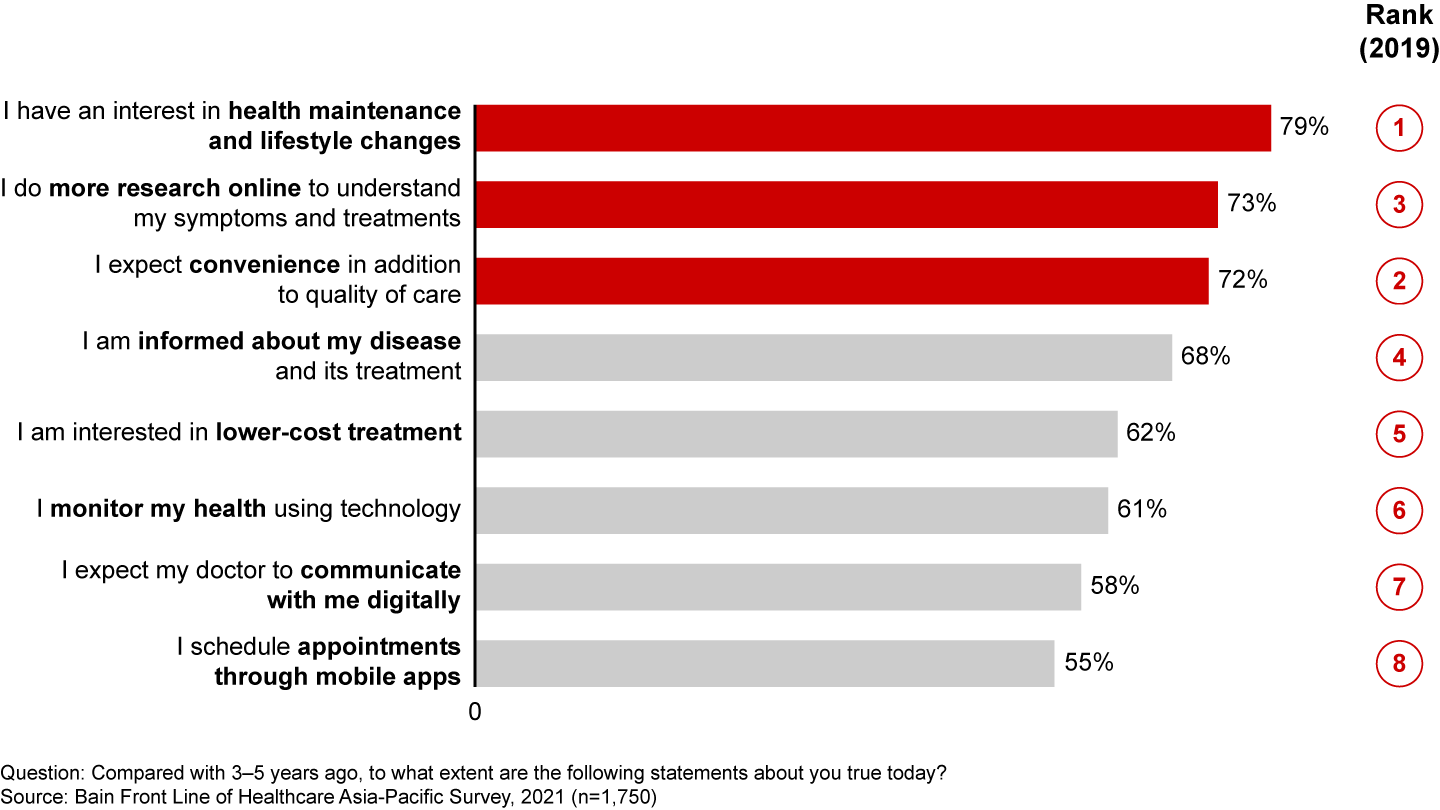
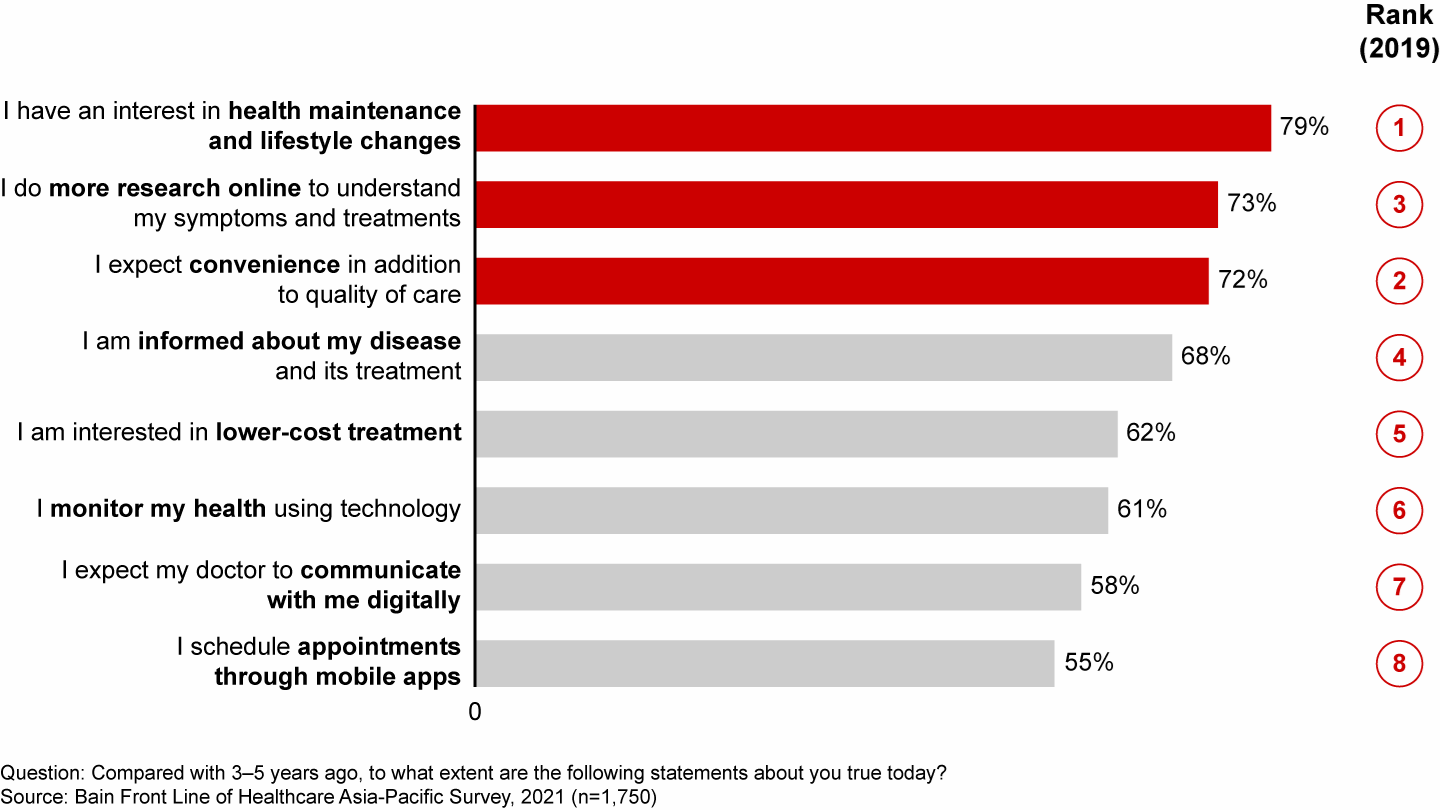
Sales for fitness wearables, such as activity trackers, increased 30% from 2019 to 2020, according to CNBC reporting. A Global Mobile Consumer Trends survey issued by MoEngage and Apptopia found that downloads of health and fitness apps jumped 157% during the first half of 2020 in India, and the number of active daily users increased 84%. In the rest of the region, digital health and fitness activity increased by about a quarter.
According to Adjust, a mobile app analytics platform, downloads tapered off in 2021 but usage remained high. Sessions increased 31% year over year, indicating users are sticking with apps—and managing their health more than they were before.
Consumers are interested in more than just apps and gadgets. Nearly half of consumers said they’re willing to pay more out of pocket for healthcare expenses in exchange for better health outcomes, experiences, and efficiencies. About a third of consumers would pay up to 20% more over the next three years; they are most willing to pay for regular and diagnostic health checkups and chronic care treatment (see Figure 2).
Nearly half of consumers are willing to pay more for better health outcomes
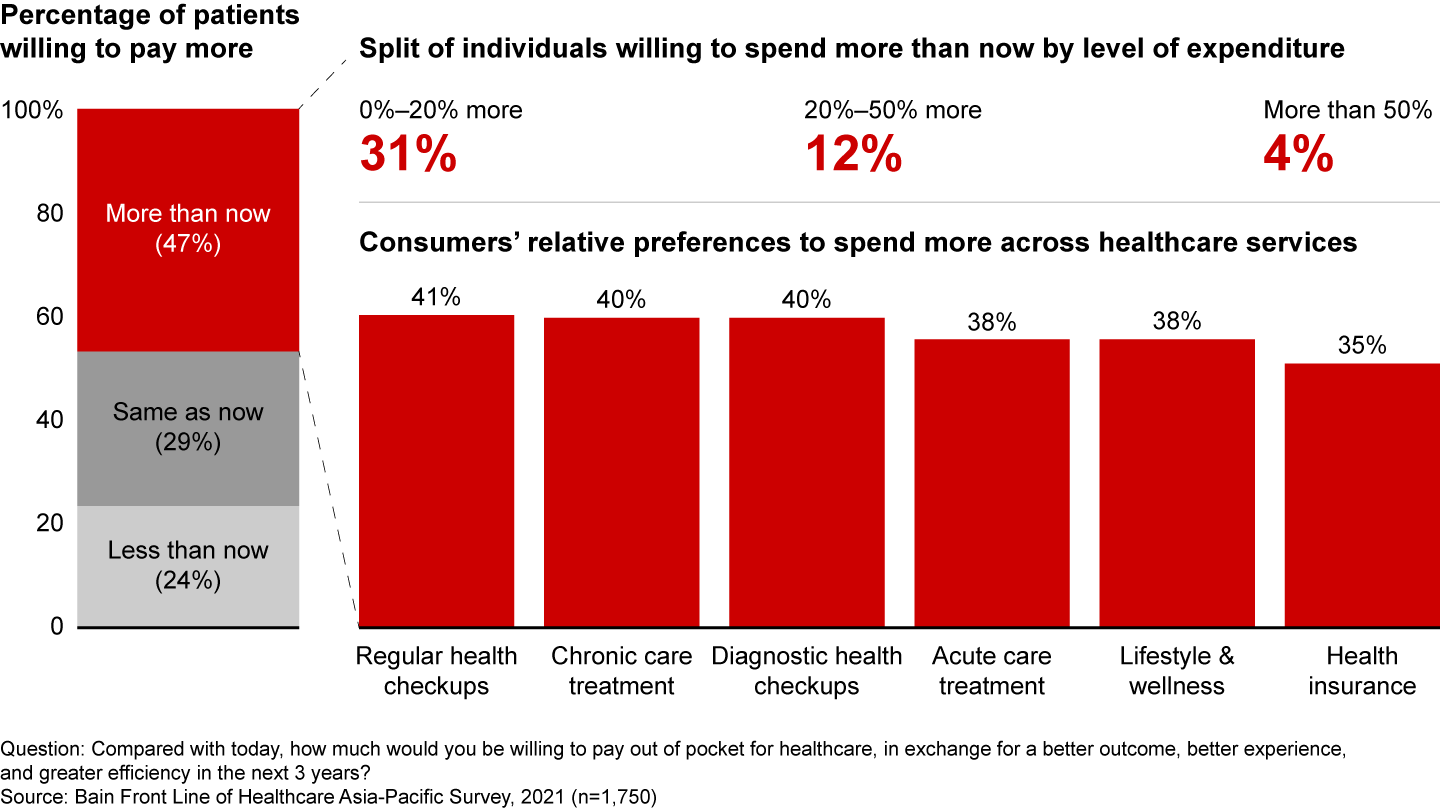
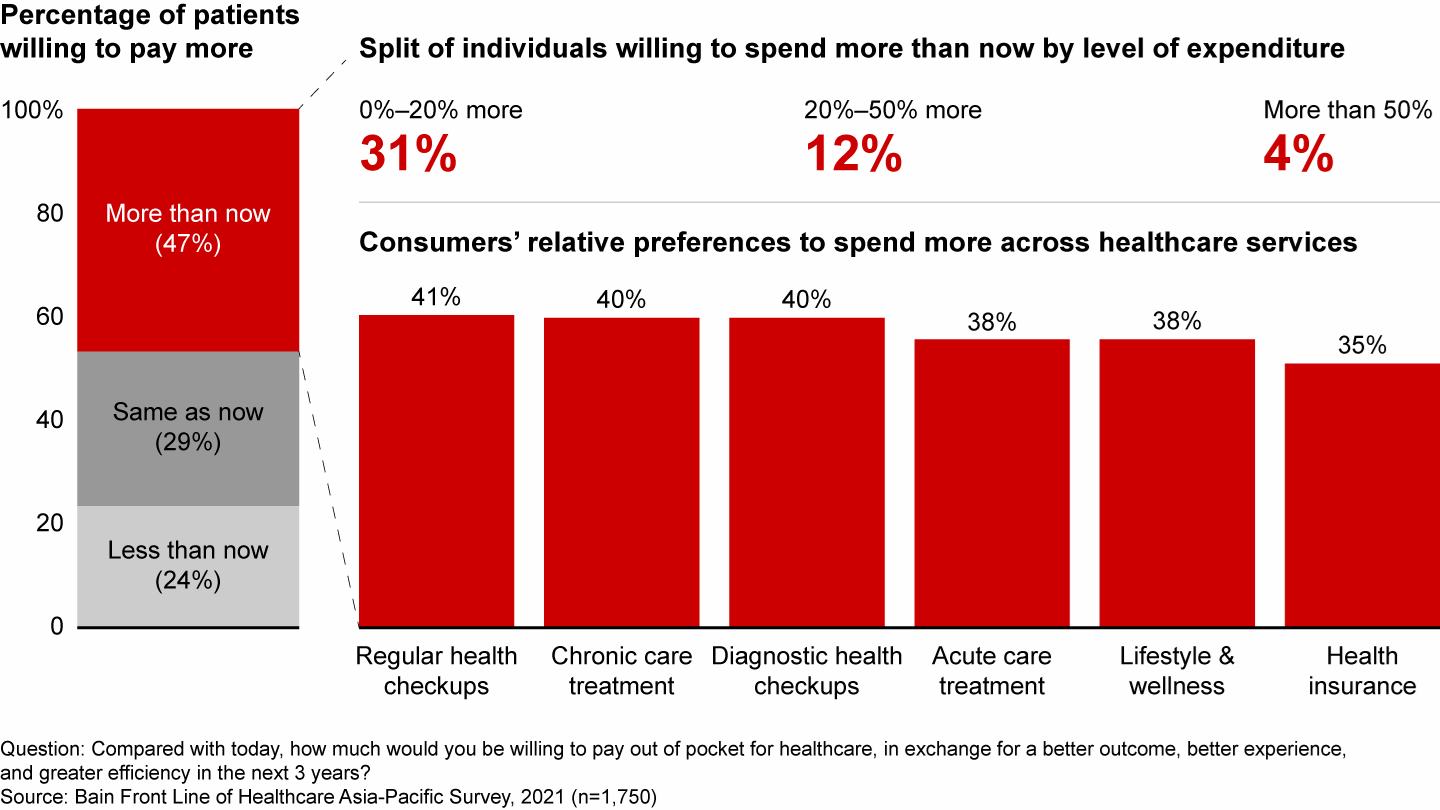
A realignment of stakeholder trust
The notion of hospitals as de facto healthcare providers is slowly fading away. The industry is rapidly moving toward delivery models that are more convenient for consumers and less expensive to deliver. Technology is helping healthcare organizations deliver high-touch services without the time or expense of physical interactions.
Many consumers are ready to explore new care options, but to transform healthcare delivery and scale digital healthcare, trust has to be realigned across the system.
In most Asia-Pacific markets, consumers trust primary care providers and pharmacies the most, with technology companies lagging far behind. On average, consumers in Australia, Singapore, Malaysia, and the Philippines trust traditional primary care providers about 30 percentage points more than digital players to coordinate and manage care (see Figure 3).
Patients trust care providers and pharmacies most, but are gaining confidence in tech companies
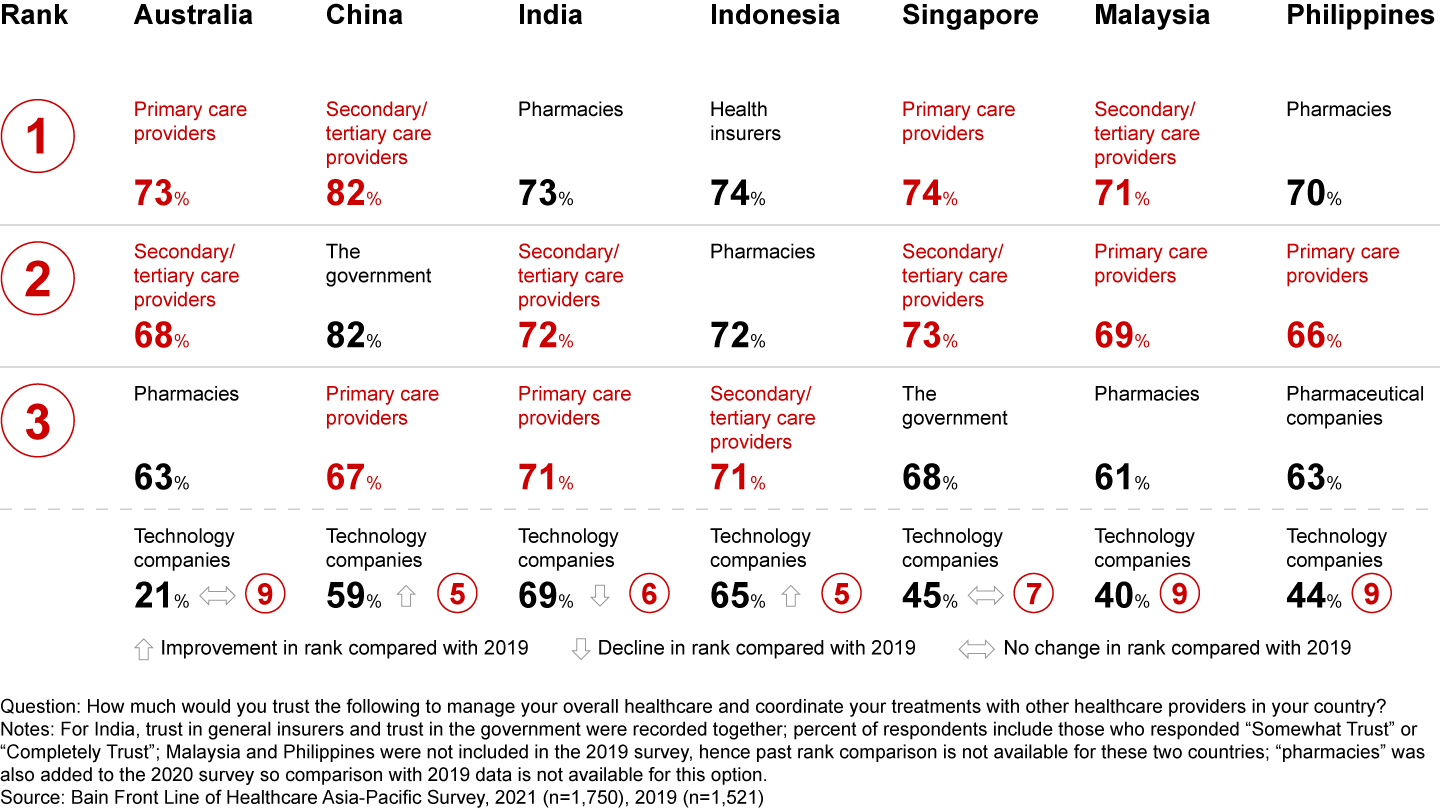
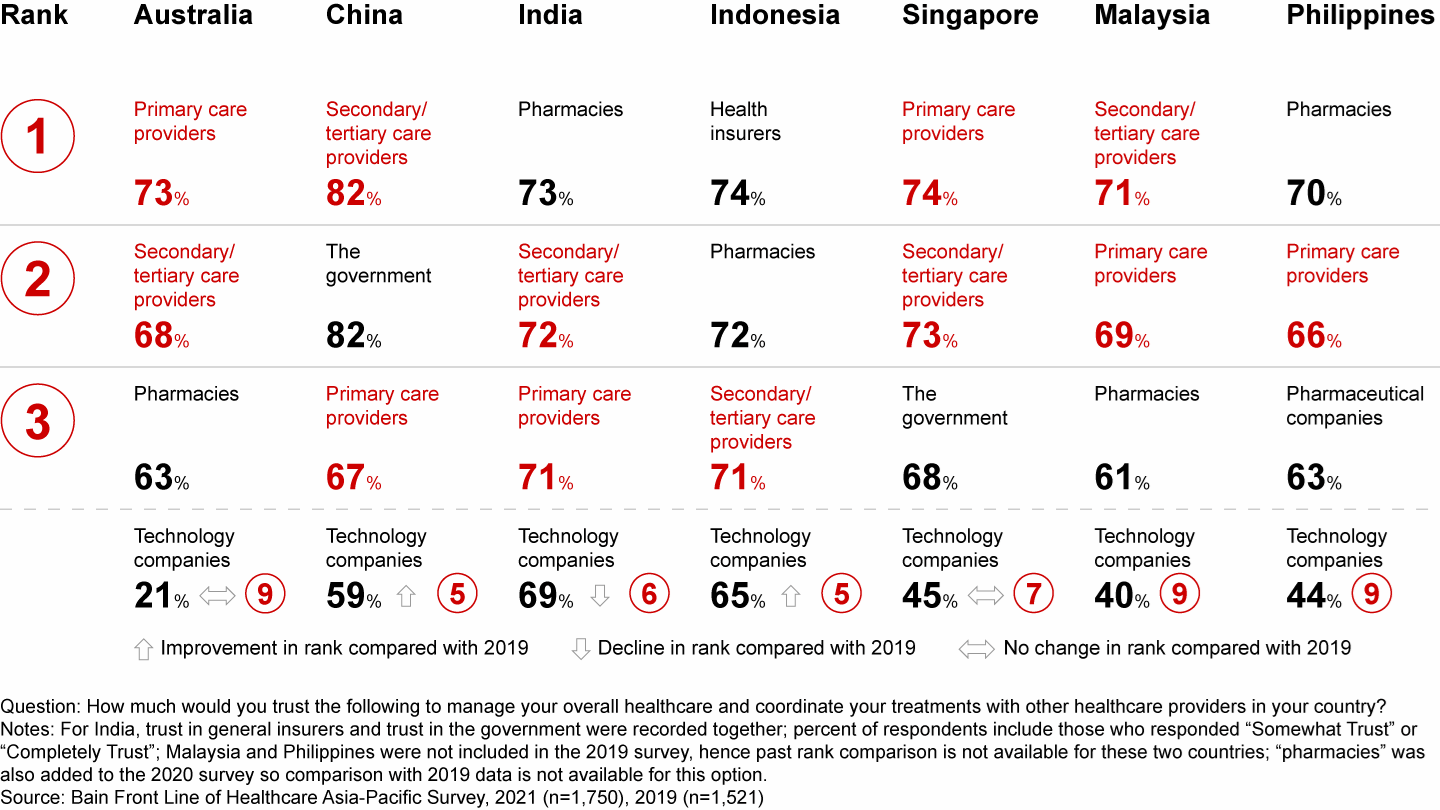
It’s unclear how long traditional care providers will hold that advantage, particularly in developing markets. Since our last survey, the gap closed considerably in India and China. There, consumers trust traditional primary care providers only 2 to 8 percentage points more than technology companies. In Indonesia, 65% of consumers trust technology companies to manage their care.
As digital adoption increases, advantages for offline providers will diminish, especially if online providers deliver comparable outcomes and greater convenience.
Physician adoption will also drive trust. Eighty percent of physicians said they use digital tools more often today than they did three to five years ago. Physicians said technology helps them manage workloads better and cited increased caseloads during the pandemic as a key driver. Compared to our last survey, telemedicine usage nearly doubled, and more physicians report using digital tools to manage chronic care, consult with patients, and perform surgeries. Use of remote patient monitoring and augmented reality tools increased 60% to 70%, and the number of physicians leveraging artificial intelligence or machine learning more than doubled. In the future, physicians will be most interested in telemedicine, augmented reality for surgeon training and pre-operation planning, and remote patient-monitoring technologies.
Increased desire for simplicity and convenience
In 2019, consumers wanted a simpler system of care—a single touchpoint to manage all their healthcare needs. That desire is unchanged, albeit intensified. More than 90% of consumers want a single touchpoint today, compared to 70% in 2019 (see Figure 4).
Patients want a single touchpoint to coordinate their healthcare needs, although delivery preferences vary by market
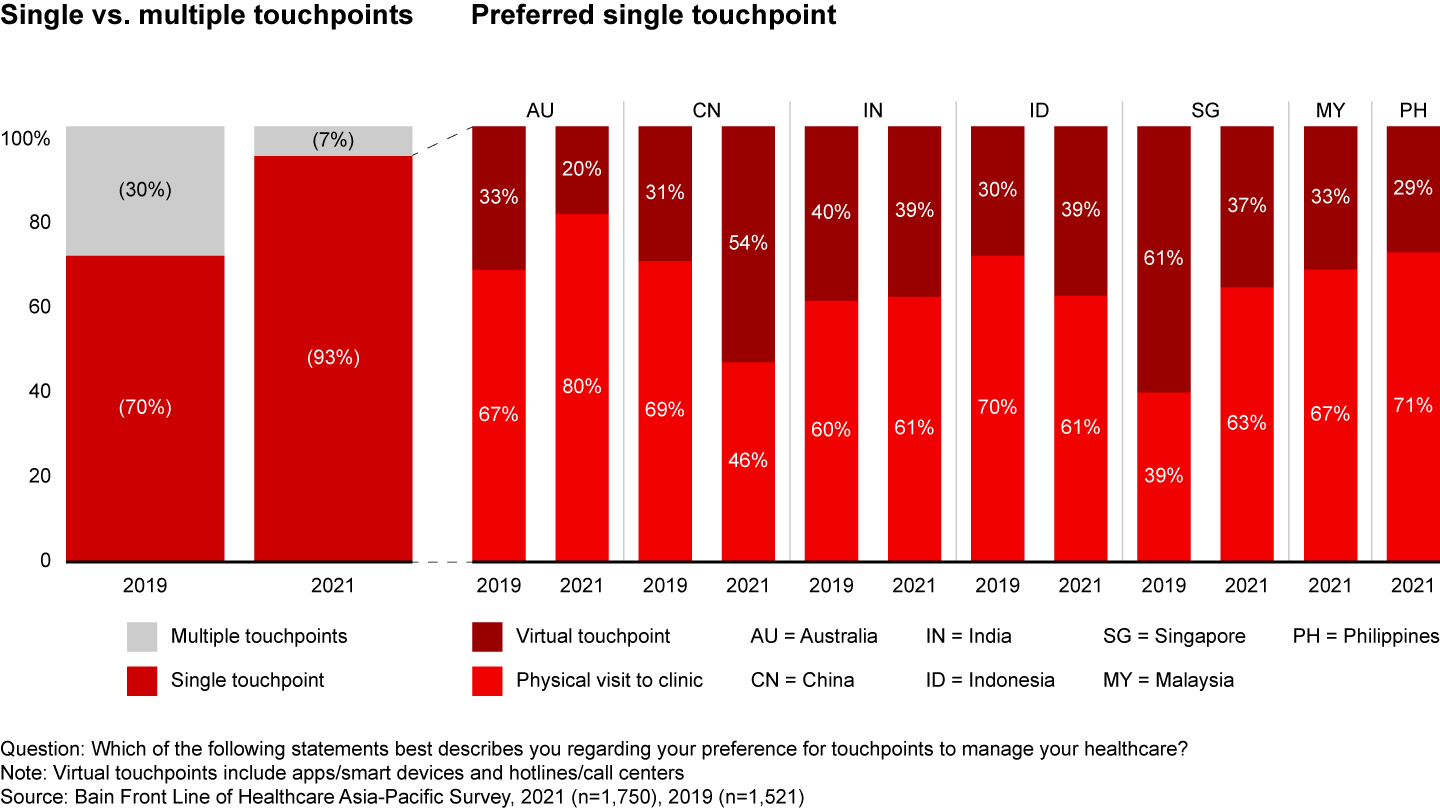
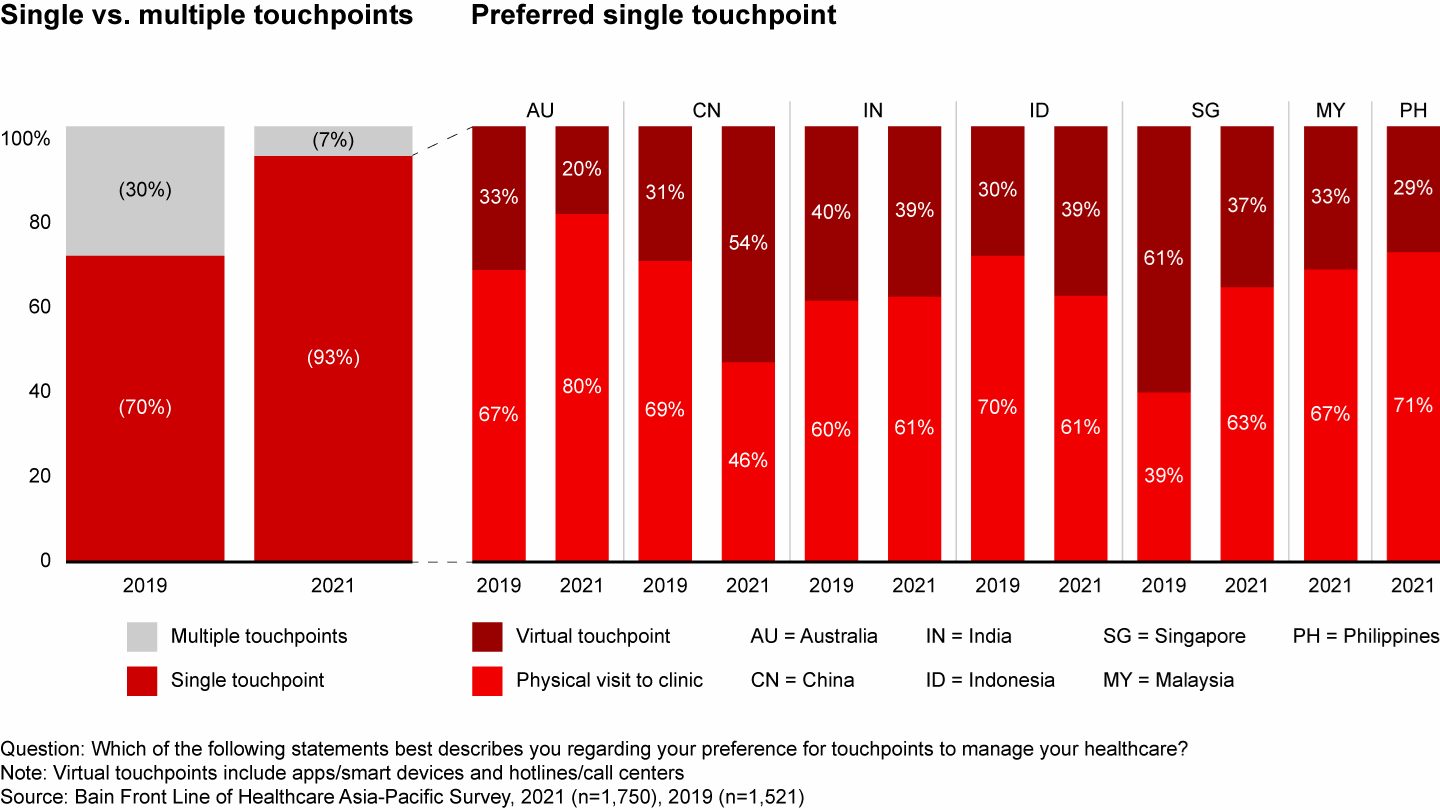
That need is being fulfilled differently across the Asia-Pacific region. Digitally native companies are racing into markets where primary care is limited. In China, for example, more than half of consumers prefer a digital touchpoint, an increase of 23 percentage points since our last report. Virtual touchpoints also gained significant ground in Indonesia.
In mature healthcare markets like Singapore and Australia, consumers favor physical clinic visits as their primary touchpoint. Their preference for in-person care increased during the pandemic. Eighty percent of Australians prefer physical visits today, compared to just 67% in 2019.
In these markets, digital healthcare isn’t replacing established systems; rather, it’s enabling more connected, hybrid experiences. Integrated offline-to-online models have the potential to deliver better patient experiences while optimizing cost and efficiencies for care providers.
New, tech-enabled healthcare norms
Since our last report, telehealth adoption soared, exceeding both consumer and caregiver predictions. Before the pandemic, about half of consumers said they expected to use digital health tools within the next five years. Now, just as many consumers have already used telehealth.
In the countries we surveyed, telehealth usage essentially doubled since 2019—except in Australia, where adoption increased ninefold. All Asia-Pacific consumers expect telehealth usage to continue rising through 2024 (see Figure 5).
Telehealth adoption increased dramatically and is expected to continue growing throughout the region
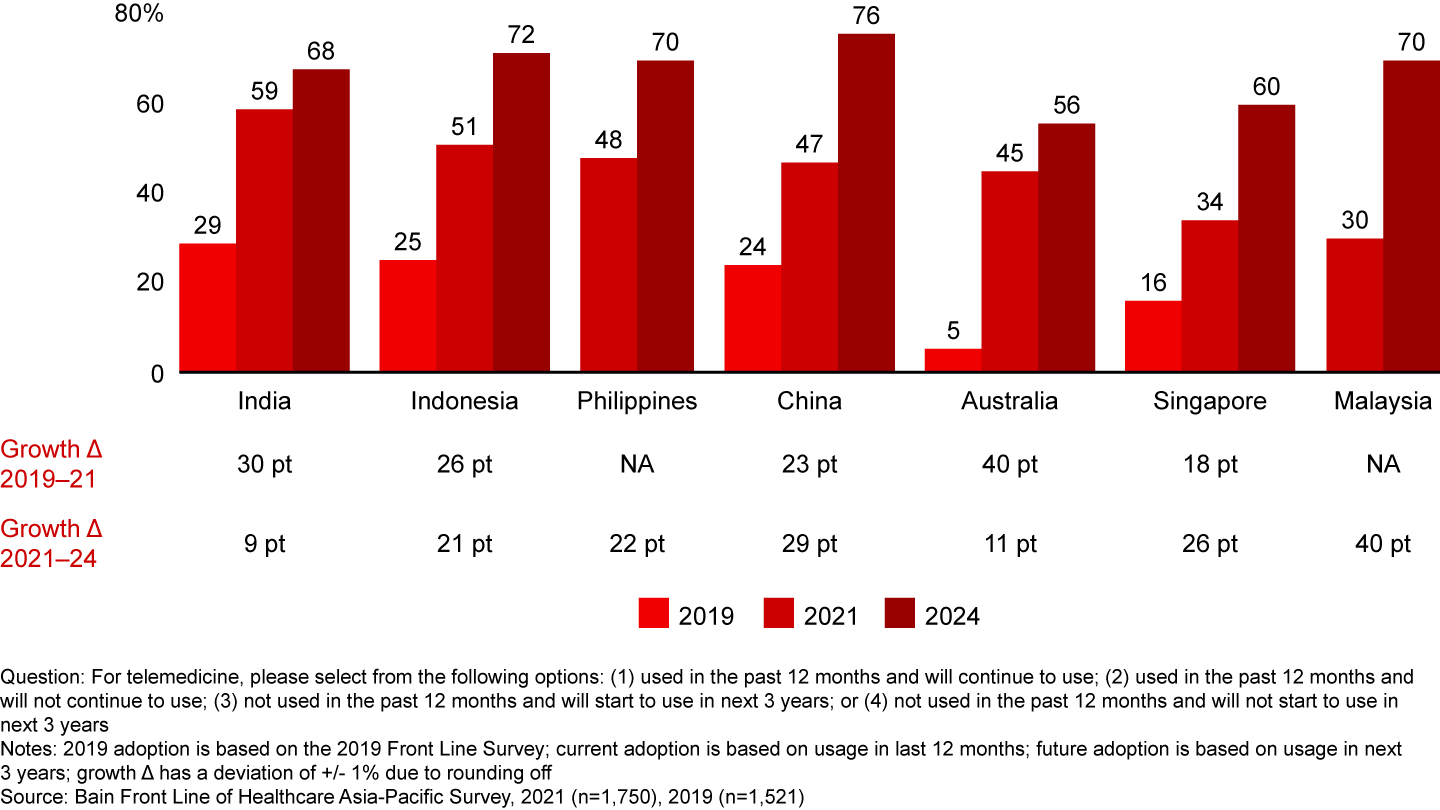
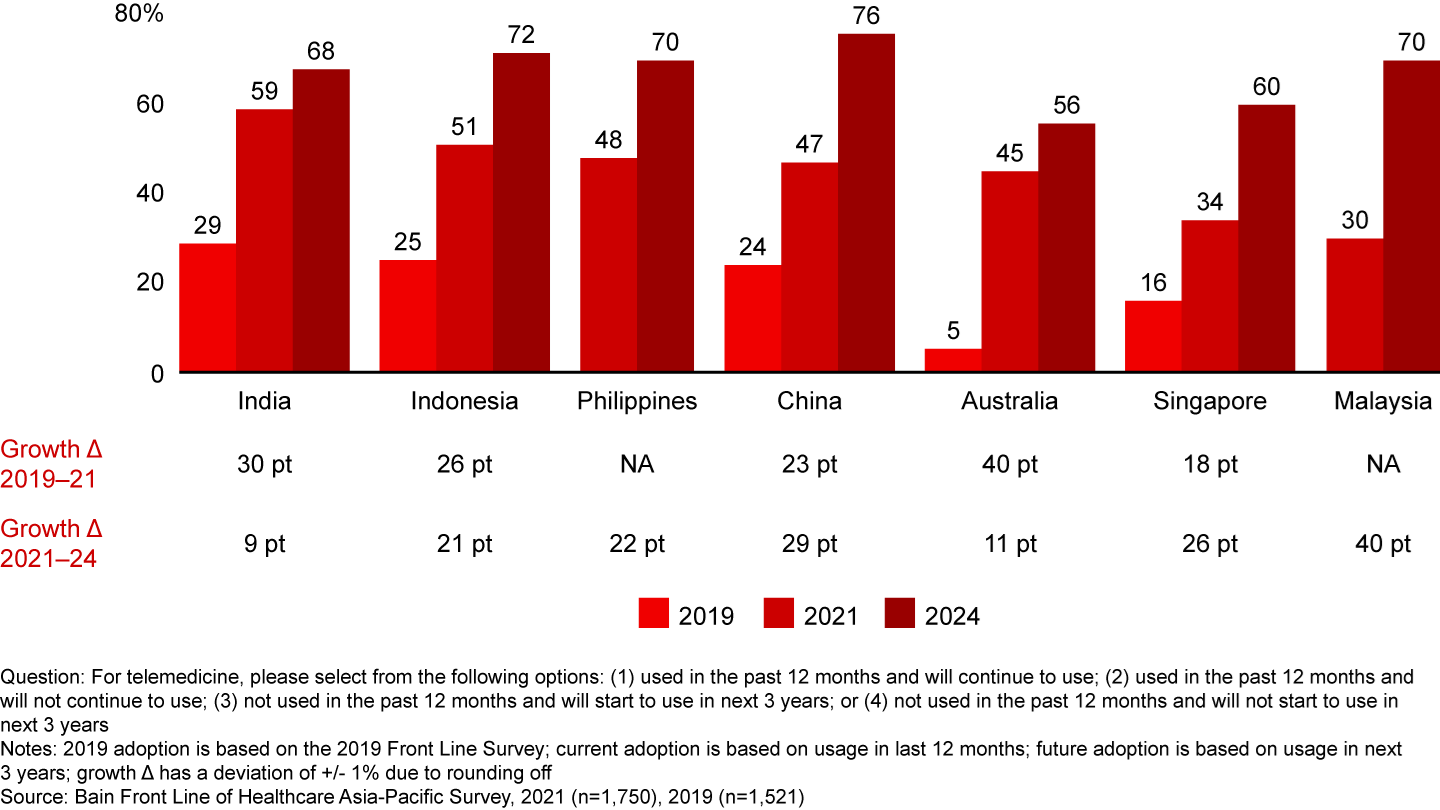
Safety risks related to Covid-19 initially encouraged the growth of telehealth. Consumers are now adopting telehealth more broadly due to its efficiency and time savings. Offline providers and pharmacies were also difficult to access during the pandemic.
Consumers reported using telehealth to manage ongoing and chronic care, access acute and emergent care, and seek second opinions. Two-thirds of consumers are comfortable visiting “any physician”—not just their primary care provider—to manage all or part of their healthcare digitally.
Physicians were enthusiastic about telehealth, too; their adoption nearly doubled since 2019 (see Figure 6). About 60% of physicians said they preferred virtual visits over face-to-face interactions due to safety reasons during the pandemic. Fifty-six percent of physicians said more than 25% of their primary consultations could be delivered virtually by 2024 (see Figure 7).
Telemedicine adoption nearly doubled among physicians
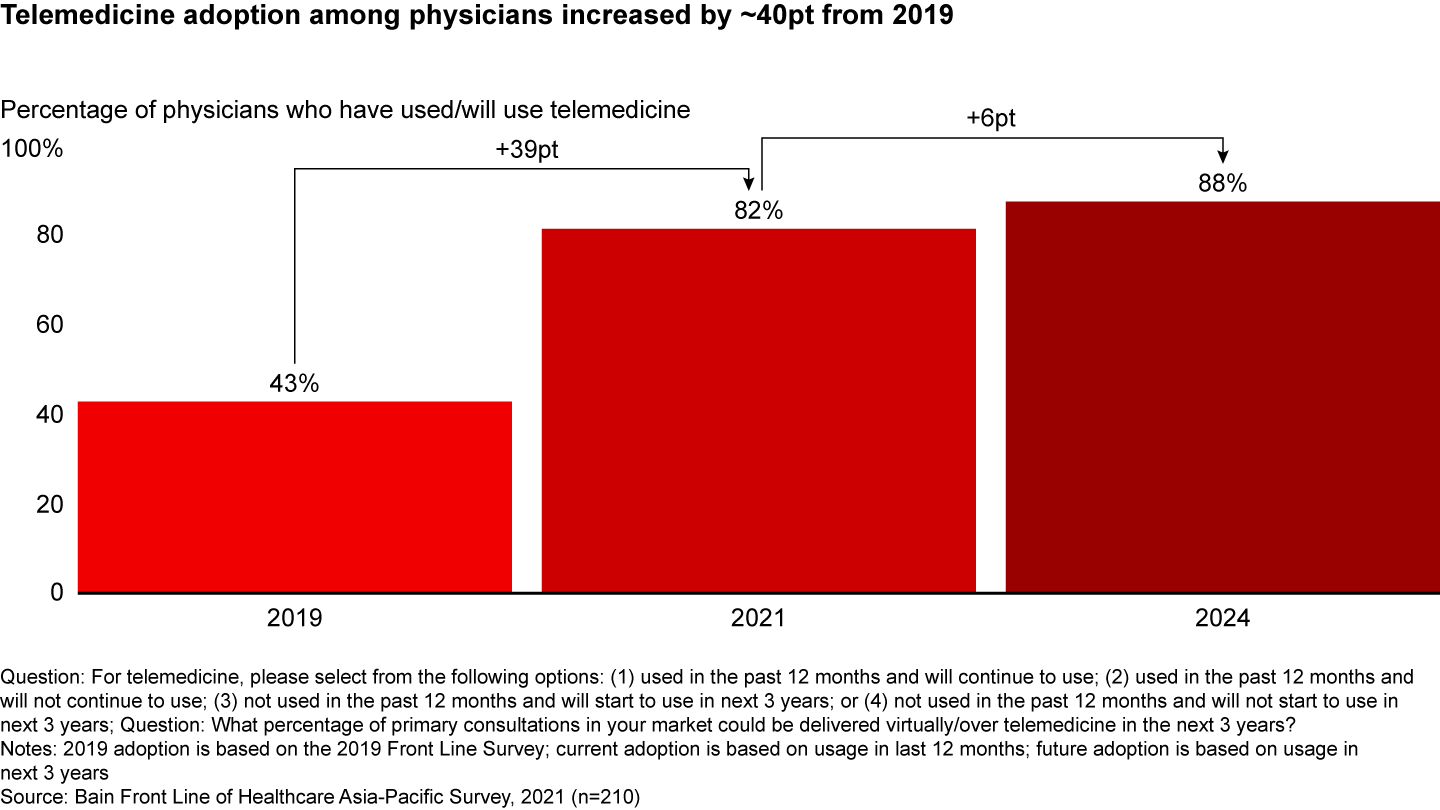
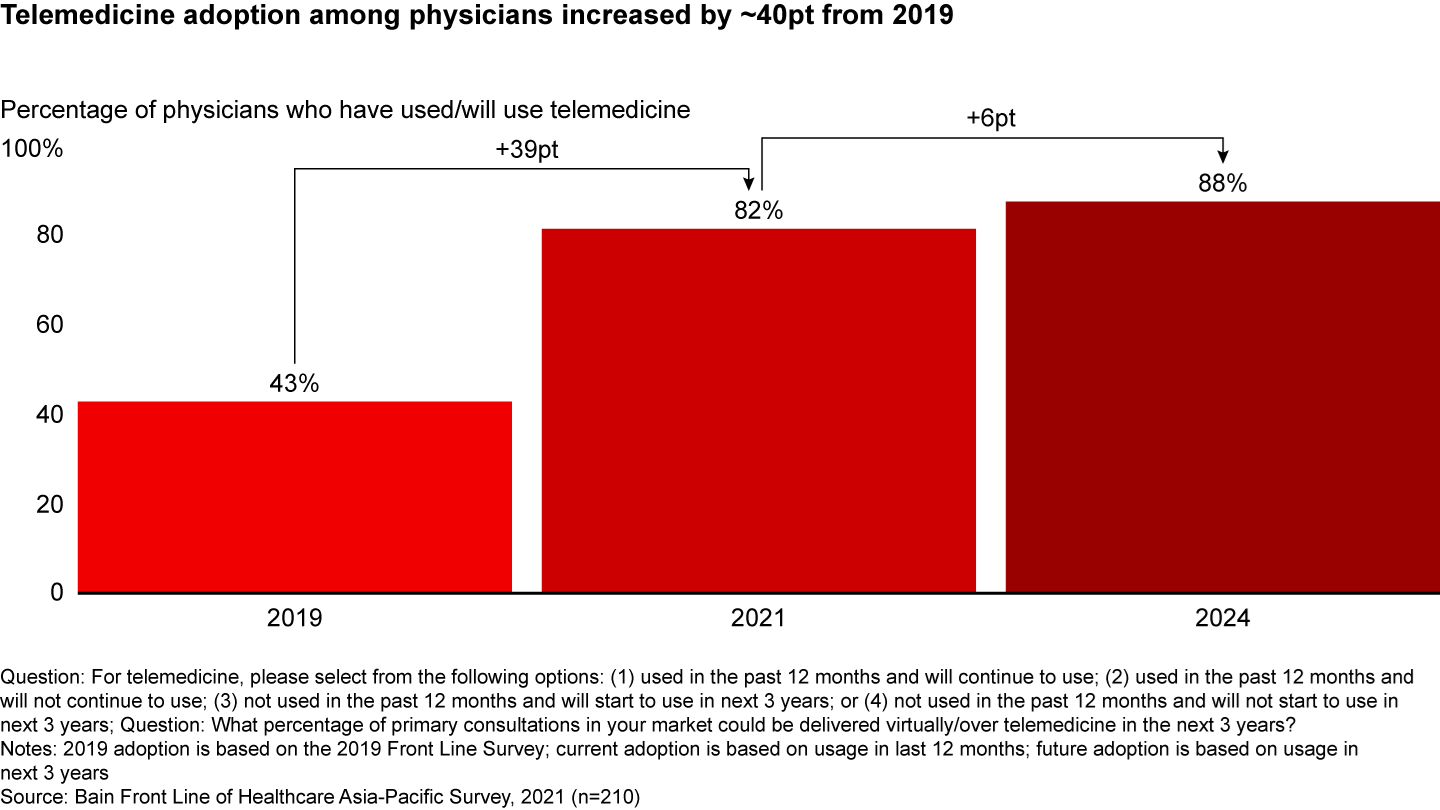
Physicians believe more consultations could be delivered virtually
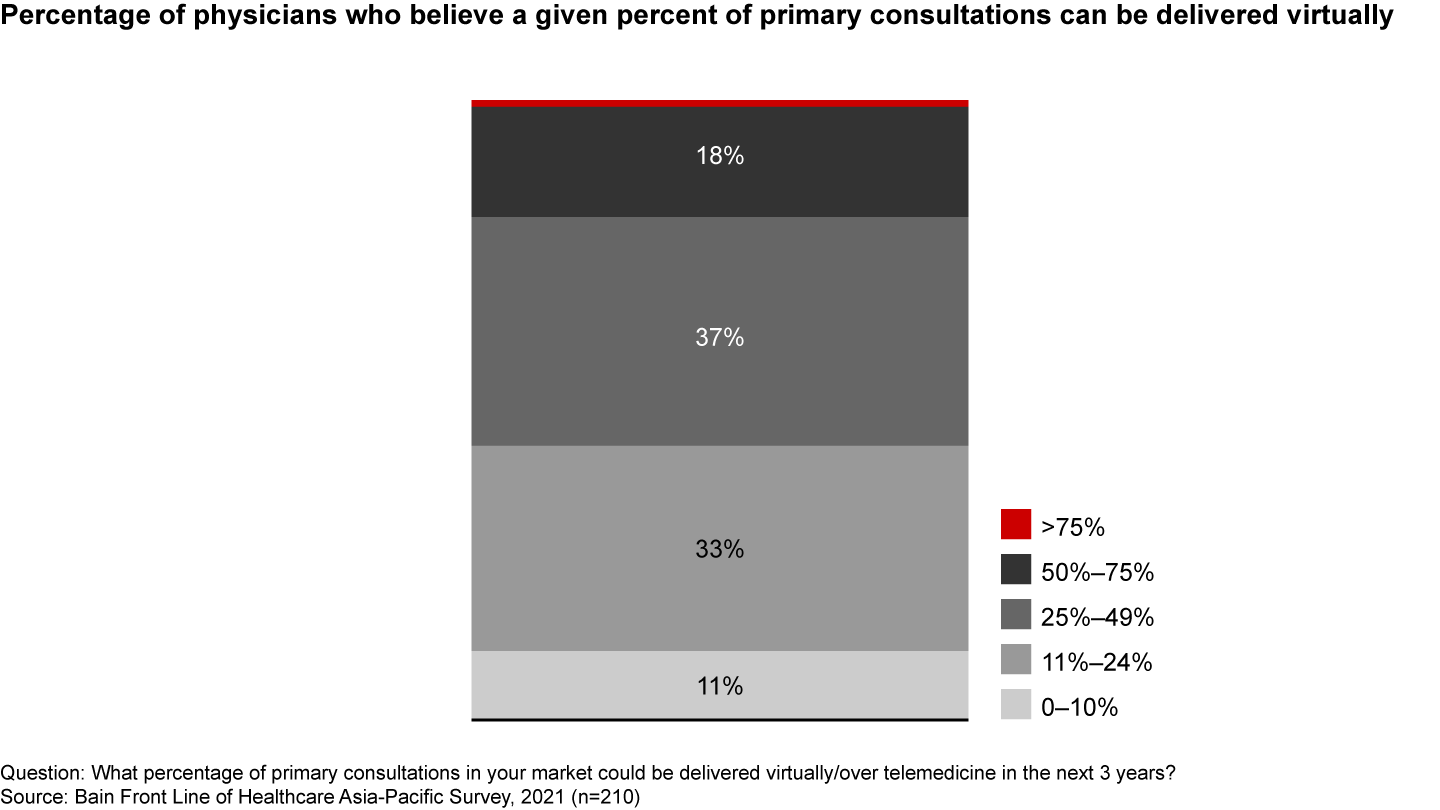
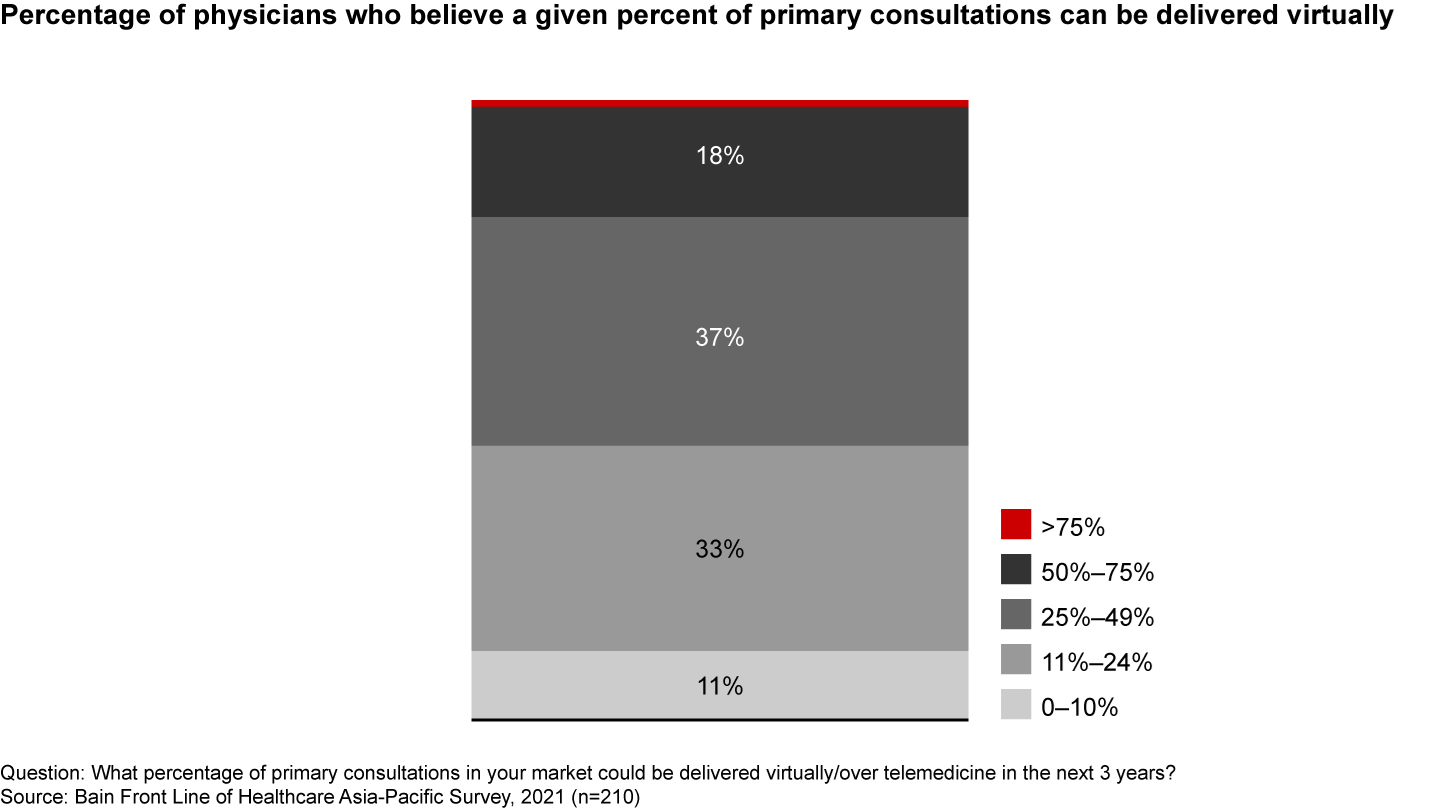
Evolution continues
Healthcare delivery rapidly evolved in the region. The pandemic accelerated innovation plans for providers and increased consumers’ propensity to engage with new delivery models. Many consumers who used digital channels for safety reasons during the pandemic will continue telehealth practices out of convenience.
Telehealth was considered experimental in 2019 and is now a normal and accepted channel for care in most countries. Government acceptance was a barrier to telemedicine before the pandemic, but one that’s beginning to wane. While regulatory restrictions persist in some countries, the pandemic shifted many government attitudes. In some countries, government actions are even supporting and progressing telemedicine. The Australian government temporarily added Medicare Benefits Schedule (MBS) items to support phone and video consultations with existing patients during the pandemic. In India, the Ministry of Health & Family Welfare deployed a national doctor-to-patient telemedicine system called eSanjeevani.
Through telehealth, everyone may be able to “have it all.” Payers and providers can lower costs, patient engagement and convenience can increase, and more populations can gain access to quality healthcare.
New reality, new opportunities
The pandemic rapidly accelerated digital health trends and fast-tracked consumer and provider adoption. Face-to-face and physical interactions will resume in some cases, but digital delivery models are now a permanent part of the healthcare landscape.
As such, healthcare organizations need to evolve, too. There are still pain points and gaps to be filled, especially in markets where primary care providers are limited. We identified four patient-centric opportunities to meet rising consumer expectations: healthcare organizations can simplify the patient journey, create integrated continuums of care, optimize and deliver value-based care, and empower patients and physicians.
Simplify the patient journey
Consumers’ desire for a single touchpoint to manage their care is not abating. Along with convenience, they want access to the best care options and full transparency surrounding costs.
Healthcare companies have the opportunity to consolidate multiple sources of data (e.g., patient profiles, behavior, clinical data, medical bills and claims) and create a single touchpoint for patients. Centralization will increase transparency and enable more personalized and cost-effective care.
A simpler pathway to care can increase population health overall. Digital delivery models have a distinct advantage over physical locations and providers and can help erase healthcare disparity. For example, access to healthcare is uneven across Indonesia. Metropolitan regions have almost five times the number of physicians as remote areas. Within cities, patients are often deterred by traffic and long waiting times. Halodoc, a health-tech platform, entered the market, pulling multiple healthcare service lines under one digital umbrella. Patients can manage appointments, prescription delivery, lab testing, consultations, and other services through a single point of contact. Halodoc estimates its virtual consultations are 70% to 80% cheaper for patients than seeing a provider in person.
Create integrated continuums of care
Physician readiness for new care sites outpaces patient readiness in some respects. More than 90% of physicians feel nonemergency services could move outside the hospital setting, but only 60% of consumers are comfortable receiving care at alternate sites. Consumers cited facilities and equipment and the availability of emergency care and qualified doctors and nurses as the causes of their concern.
For both practical reasons and consumer preference, a hybrid model of care will be necessary in the future. Healthcare companies can develop seamless exchanges between their online and offline delivery models and along the care continuum. As telehealth develops, it can also guide patients—steering or triaging them—toward the right delivery model.
During the pandemic, Raffles Medical Group in Singapore added mobile and remote services to improve healthcare access. A search-and-scheduling app empowered consumers to find Covid-19 tests, providers, and specialists, which helped to reduce wait times for in-person care. Raffles is expected to integrate health insurance into its platform soon, coming full circle for patients on a single platform.
Optimize and deliver value-based care
As consumers become more involved in their care—and more willing to pay for it—this will challenge the traditional fee-for-service model. Healthcare companies need to deliver better customer experiences and outcomes—i.e., more value—to attract and retain lifelong patients. There are many untapped opportunities to increase value for patients before, during, and after care.
In Australia, NSW Health enlisted clinical and nonclinical support to shift its focus from “output” to “outcomes.” Its Leading Better Value Care (LBVC) initiative is designed to deliver the right care at the right place at the right time to increase value for patients.
LBVC includes a framework to measure the patient experience and patients’ perceptions of their care, health status, and clinical outcomes. The health system has 13 focus areas for delivering value-based care; most include conditions with complex or ongoing care needs, such as diabetes or wound management. In these areas, NSW Health focuses on increasing clinician coordination, patient education, and patient-perceived outcomes.
As more health companies move toward value-based care over fee-for-service models, expect more emphasis on preventative health, convenience, and customer service.
Empower patients and physicians
More than 70% of consumers say they conduct research online to understand their symptoms and treatments, and more than 60% use technology to monitor their health. Consumers want access to their health information so they can take control of treatment plans and chart their own pathways to care.
Consumers are willing to “see any doctor” for acute treatment and want easy access to their primary physician for ongoing and chronic care. Health systems have to staff and support virtual-care providers to match demand and connect patients to the right care teams.
Providers need the right technology and digital tools to deliver secure, quality services through virtual platforms and to work more efficiently. Providers also need access to historical patient data, such as visit summaries and lab reports.
One company is trying to build a healthcare ecosystem to support physicians and patients. Tencent believes it can increase digital engagement and training among physicians by taking information to platforms they already use. Tencent created a physician education program within WeChat, a Chinese app with more than 1 billion monthly users. About 70% of Chinese physicians use WeChat for more than 30 minutes a day.
In 2019, the Chinese Medical Doctor Association (CMDA) partnered with Tencent to build a WeChat app for continuing education and to issue digital “provider cards” to authenticate physicians.
Tencent also targets consumers with information about chronic disease management, healthcare products, and insurance options. Its WeDoctor app connects users to more than 270,000 healthcare providers and more than 7,000 hospitals that offer telehealth, making it a one-stop shop for consumers who are in the market for care.
Strategic implications
Healthcare companies should invest in differentiating digital capabilities to capitalize on these opportunities. We see four promising strategic plays:
- Accelerate the patient experience
- Digitally transform the front line
- Reimagine processes and operations
- Disrupt data silos
Accelerate the patient experience
Now that telemedicine and hybrid healthcare models have been normalized, consumers have new expectations about the services they receive, both in person and virtually. Healthcare companies need to remap patient and provider journeys to ensure coordination and integration are complete. For example, at a minimum, physicians need access to patient data during virtual consultations.
Providers also need mechanisms to measure the patient experience, such as the Net Promoter Score℠, which measures a consumer’s likeliness to recommend a provider or service. Patients are the center of healthcare, and their feedback is a valuable asset.
Ideally, telehealth and digital platforms will create synergies between both care delivery models. Consumer feedback can help companies uncover the most patient-centric opportunities to improve experiences, outcomes, and value.
Digitally transform the front line
Digital transformation needs to drive three key outcomes for patients, physicians, and providers: transformative patient experiences, world-class clinical outcomes, and operational excellence.
To be transformative, experiences need to be seamless across the care continuum for the entire length of the patient journey. Clinical outcomes can be augmented by more personal treatment plans and enhanced capabilities to predict disease, treat symptoms, and time interventions. Digital solutions can automate processes to increase efficiency and improve treatments and the experiences surrounding them.
Transformations aren’t about “standing up apps.” Successful digital-health offerings integrate online and offline experiences, embed digital tools and processes, and interconnect key workflows. Aided by technology, frontline doctors, nurses, and administrative staff can collaborate more easily and deliver omnichannel healthcare experiences to consumers.
Digital capabilities also need to deliver speed and agility. To deploy and scale solutions quickly—while they are still competitive differentiators—most healthcare companies need support. Leaders need to weigh the strategic trade-offs of owning technology vs. partnering with others. An ecosystem of vendors and partners may be the quickest route to strong and secure digital capabilities.
Reimagine processes and operations
Traditionally, consumers only interacted with healthcare systems when they were sick. A patient would show up at the hospital, receive treatment, and be sent home. The relationship revolved around an incident, not the person’s lifestyle or longer-term well-being.
That dynamic is shifting. Relationships are starting much earlier in the patient journey and developing outside of healthcare facilities. More patients are researching conditions independently, seeking out providers and referrals, and influencing decisions about their care.
Healthcare organizations can respond by designing more customer-led care models. Such models are multidisciplinary, but also location- and channel-agnostic. A customer-led care model considers all of a patient’s needs and designs a journey that optimizes outcomes, experiences, and costs. Simpler prescription experiences, health monitoring services, and remote physician support can ease a patient’s pathway to wellness—not just to healthcare.
Marketing, referral programs, and operations must adapt to these shifts in consumer behavior, too. Content strategies should answer patients’ desires for more education, options, and support. By doing so, healthcare brands can position themselves as trusted partners, drive engagement, and convert consumers. Referral processes that leverage technology and automation can help consumers find the right specialist for a condition—and for their location, network affiliation, or other preferences (e.g., language or physician’s gender).
Disrupt data silos
Patients accumulate enormous amounts of data. In that data lies opportunity.
Data and analytics can be used to support clinical decisions and improve outcomes, manage population health, optimize operations, collaborate with payers, and improve the customer experience.
The key is capturing more information digitally and bringing it together in a centralized data lake where it can be expertly interrogated. Right now, most organizations measure services provided and associated costs, but fail to link the data points back to the patient journey. Information needs to be captured digitally, centralized, and connected to the patient experience.
With more data and the skills and tools to leverage it, healthcare organizations can do better for patients.
What’s next?
The public health crisis forced healthcare companies to accelerate innovation plans and deliver care in new, patient-centric ways. Patients have always been important. That did not—and will not—change. But now, healthcare companies understand what’s important to patients.
As they continue to transform and evolve, healthcare companies will find new ways to deliver quality outcomes plus convenience and efficiency. Digital skills and partnerships will be necessary to meet new demands and serve a more empowered segment of patient-consumers.
Research methodology
The 2019 survey included consumers in Australia, China, India, Indonesia, and Singapore. In 2021, consumers were surveyed in the same countries, plus Malaysia and the Philippines. Because Malaysian and Philippine consumers were not included in the 2019 report, they are excluded from some comparative data.
Physicians from Australia, China, and India were surveyed in both 2019 and 2021.
Net Promoter®, NPS®, and the NPS-related emoticons are registered trademarks of Bain & Company, Inc., Satmetrix Systems, Inc., and Fred Reichheld. Net Promoter Score℠ and Net Promoter System℠ are service marks of Bain & Company, Inc., Satmetrix Systems, Inc., and Fred Reichheld.